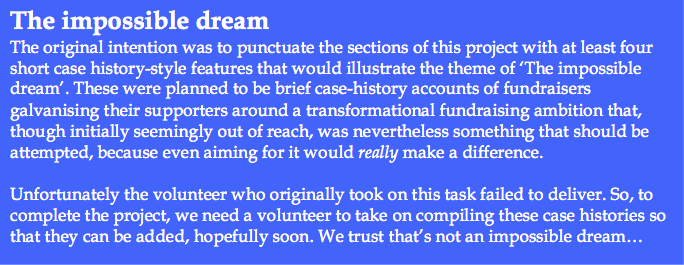CDE project 6 the full contents and purpose
CDE project 6. The use and misuse of emotion.
- Written by
- The Commission on the Donor Experience
- Added
- July 07, 2017
Purpose, methodology and detailed contents and structure
Purpose
The purpose of this project is to equip fundraisers everywhere with a broad understanding of emotions, their importance, power and potential, plus to offer practical guidance on how to access and employ them wisely and responsibly in their fundraising, to enhance their donors’ experience.
Methodology – the approach
Fundraising is inevitably emotional and emotion is hugely powerful, so must be used responsibly and wisely. This project considers whether emotion can be safely used in fundraising communications and how best to use it. It has set out to define the opportunities and responsibilities that come with telling the truth well, with power and passion that can move people to action.
To add substance to this project and to cover areas of expertise that are beyond my experience and ability I’ve invited contributions from a wide range of experts and enthusiasts. These splendid people are listed in the contents and in the introduction. I’m grateful to them all and confident that if you give their submissions the attention they deserve, you will be too. For interest I’ve also added in a few fairly random examples of my own, including aspects of emotions and how we interact with them.
I’ve attempted to distil key lessons from each contributor and present these in the summary as 72 key lessons and helpful hints. Though I’ve done my best to include everything that I feel may be of use to other fundraisers as they explore this subject for themselves, the careful reader will easily find lots more good and useful content among the various sections and contributions.
The key points and conclusions in the summary are based on these expert submissions, on what I’ve learned from five years jointly running a three-day emotional fundraising workshop on the shores of Loch Ness with Alan Clayton and on my personal experience generally. They’ve also been informed where appropriate by the CDE’s donor view surveys.
Please do add to this project. It is genuinely a work in progress that, while it may never be complete, has plenty of room to improve.
The contents and structure
The trailer
A two-minute taster for what’s described as the biggest challenge of them all.

Section 1: an introduction to emotional fundraising
- The summary: fundraising is inevitably emotional and emotion is hugely powerful, so must be used responsibly and wisely.
- The introduction: why emotion is important. But, it doesn’t just belong to fundraisers. Including a short movie, some acknowledgements and a caveat.
Section 2: the emotional fundraising showcase
This section is mainly composed of videos and PowerPoint presentations, which are self-contained and need no introduction. To get from one to the other, just click the links below, then scroll down. From 2.1. to 2.13. are in the first link, the short videos are in the second.
The emotional fundraising showcase
The emotional fundraising showcase videos
2.1. The magic of oxytocin. Why emotional storytelling works so well.
2.2. Caius and Marcellus. The two types of story.
2.3. London’s bid for the 2012 Olympics.
2.4. The cruel sea. RNLI’s lifeboatmen, and the role of the hero.
2.5. The remarkable story of Gabriella’s feet
2.6. (Possibly another story to follow)
2.7. Going over the top. Why emotional memories matter.
2.8. Every parent’s worst nightmare, by Ken Kesey.
2.9. Hope and Play’s thank-you email.
2.10. University of Maryland. A thank-you letter that fails.
2.11. University of Warwick. A thank you email that works.
2.12. George Orwell on emotion.
2.13. Great emotion on SOFII and The Agitator.
All of the above content can be found here. And all the films/videos below can be found here.
2.14. Emotional fundraising showcase: the movie and video collection.
- 2.14.1. Street concert short movie from Thai Good Stories.
- 2.14.2. MS Holland, Dancing with dad television advert.
- 2.14.3. TD Bank USA Sometimes, you just want to say thank you tv advert.
- 2.14.4. Father and son Thai Life television advert.
- 2.14.5. My dad is a liar Thai insurance co Metlife television advert.
- 2.14.6. Cause the wave. EB research: the most insane skin disorder you could imagine.
- 2.14.7. Canadian Cancer Society 1: One child with cancer is one too many.
- 2.14.8. Canadian Cancer Society 2: Where is Sean now?
- 2.14.9. Save the Children television advert Still the most shocking.
- 2.14.10. Macmillan Cancer Support tv advert. You’ll never walk alone.
- 2.14.11. Oxfam GB television advert Be Humankind.
- 2.14.12 The world’d biggest asshole, from The Agitator.
- 2.14.13. The most emotional video ever.

Section 3: the science of emotions
3.1. What are emotions? Francesco Ambrogetti.
3.2. How behavioural science points to better relationships. Dr Kiki Koutmeridou.
3.3. Helping people feel good about giving. Alan Clayton.
3.4. Emotional intelligence. Jen Love.
3.5. Emotion. Some useful background and pointers from Wikipedia.
Section 4: emotion and donors
4.1. The donor’s view. Some charity supporters give their perspectives on emotional fundraising and what it means to them (sadly this research didn’t materialise in time to be included in this project. Some insights on how donors view emotional fundraising can be seen here).
4.2. The positives and negatives of emotional fundraising. Jenny-Anne Dexter
4.3. Me the storyteller. Russell Benson.
4.4a. Shifting hope. How hospices get their messaging right. Dr Suzi Attree.
4.4b. Jack’s story. Claire House Hospice.
4.5a. It’s the picture, not the frame. The use and misuse of emotional images. Lyndall Stein.
4.5b. Fear, flight and fight. How to manage emotions. Lyndall Stein.
4.5c. The Dochas code. Help to avoid abusing emotion.
4.6. Bridging the empathy gap. How emotional storytelling might change public perceptions. Steven Dodds, Kate Woodford and Joel Du Bois from Harvest Strategy Partnership.
4.7. Negative and positive images. Jeff Brooks.
4.8. Craig Linton and Paul Stein on emotion.
4.9. To the edge of acceptability. Helen’s trial, from BBC Radio 4’s The Archers.
4.10. Keep it simple. Brock Warner.
4.11. An emotional event (to follow).
Section 5: the inspiration business
5.1. The creative use of emotion Mark Phillips.
5.2. The starfish story Robbie Macmillan.
5.3. Emotional conversations. How speaking to donors on the telephone is changing, for good. Lauren Semple and Sharon Comfort from Karat Marketing.
5.4. Creating an emotional organisation
-
5.4a. How leaders use emotion. Jayne George.
-
5.4b. The moody leader. Ken Burnett.
-
5.4c. The emotional major donor. Tammy Zonker
-
5.4d. The emotional board. Tesse Akpeki.
5.5. Seven other things to think about.
-
5.5a Seven other things, inc a short video about passion. Ken Burnett
-
5.5b Empathy-based design, Adam Willis.
Section 6: the shape of emotional fundraising in 2017
The shape of emotional fundraising in 2017: some future-gazing, new approaches and conclusions, the 37 key considerations for relationship fundraisers and 47 helpful tips for emotional fundraisers, slightly expanded and attributed.
How to use this project
This project, in its five main sections with 40 individual components from 26 principal contributors and numerous indirect supporters, tries and inevitably fails to give a comprehensive picture of the use and misuse of emotion in fundraising. I’m neither surprised nor displeased by this failure. Emotional fundraising is a vast, complex subject that’s still in its early stages of unravelling, scientifically and in practice. Of course there’s a lot more to learn. So this has to be a work in progress, a starting point that fundraisers everywhere will have access to and encouragement to add to.
No one doubts the power and importance of emotion, though emotion makes many people so uncomfortable that it’s frequently avoided, played down, minimised and even distorted. What’s needed by aspiring donor-focused fundraisers is a handy digest of how to use emotions and how not to use them too. The edited summary is an attempt at that.
You’ll see from the detailed contents list for CDE project 6 that you can easily spend days and even weeks exploring the good stuff that’s been assembled. The purpose of the summary is to help you gather the best bits, the main lessons, in inside an hour. The project has so many talented contributors and such good content from them that it’s hard to paraphrase. For the full project with all its components in downloadable form, please go to. (Links to the content will follow).
Ken Burnett, 24 January 2017.
















